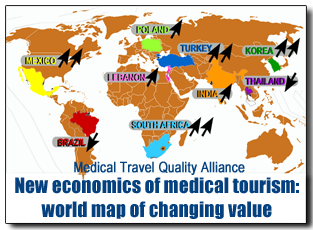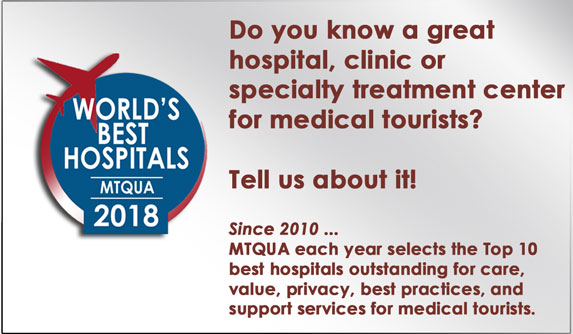 How much value does a medical tourist really get when going abroad for medical treatment?
How much value does a medical tourist really get when going abroad for medical treatment?
What is the true cost of a hip transplant for a medical traveler? What is the going rate for a medical tourist’s breast augmentation? Should one travel to India or to Mexico to get the best savings from a coronary angioplasty?
It depends.
View the charts in this infographic.
Real value in medical tourism
The cost a medical tourist pays for procedure or treatment depends, more than ever, on the exchange rate between the currency the medical tourist uses at home and the currency used at the medical destination.
Is the medical traveler paying in US dollars, British pounds, Swedish krone or Burmese kyat? Is the receiving country charging in Indian rupees, Korean won, Polish zloty or Turkish lira? Relative exchange rates, or currency to currency differences, matter as countries variously go into and emerge out of economic uncertainty.
Medical tourism value in Thailand, Malaysia, Brazil down
While currencies like the Thai baht and the Malaysian ringgit have become stronger over the recent years, other currencies have weakened significantly, some by almost 50 per cent.
Medical tourism value in Mexico, Turkey, South Africa up
Looking strictly at exchange rates, countries such as Mexico, Turkey and South Africa now may offer much better value for money than Thailand or Malaysia for medical travelers. India seems to be holding steady as a medical destination of value so far, although business interests in India are expressing concern that higher interest rates will result in a stronger rupee and reduce the country’s global competitiveness.
Weak vs. strong currencies
The 2005 seminal medical tourism report from the World Bank compared costs of several surgical procedures in a number of countries. Today, Brazil’s currency, along with Thailand’s, is strong and surgery costs in both countries have increased significantly for anyone paying in U.S. dollars. According to World Bank figures, cost of shoulder arthroscopy in Brazil has increased between 2003 and 2010 by more than 60 per cent, from U.S. $5,600 to $9,400.
By contrast, India, Mexico and Singapore exchange rates have remained fairly steady and corresponding surgery costs relative to the US dollar haven’t changed much in the eight years the report considered: a hernia repair still costs as little or less in Mexico or India as it did in 2003.
Eroding values, disappearing savings
In another telling example, the cost of breast augmentation in Thailand is still widely listed across the internet at about $3,000 – $3,500 although this cost first was published in 2006. Today, because of the currency differential, this cost is actually 25% higher. $3,750 – $4,500 is a more accurate representation.
Given that prices in the U.S. for breast augmentation are highly competitive, the expected cost saving for a U.S. origin patient may well be negligible, once travel and other costs are included.
Competition
As popular medical destinations like Thailand and India face economic and political pressures both domestically and globally, they now also face growing competition from lesser known medical destinations and medical providers that is being spurred on by the new economics of medical tourism.
Aggressive marketing
Some of these emerging “medical destination” countries are beginning to aggressively position themselves as significant actors in the medical tourism. Korea and Turkey are the most significant new players to threaten the old order.
Hidden value
As value in medical tourism shifts from Malaysia, Thailand or Brazil, other countries like Mexico, Turkey and South Africa begin to look more desirable as medical destinations. Beyond these, some lesser known medical destinations may be hiding a foreign exchange secret. Will Poland, for example, one day become a preferred medical tourism destination? Even Vietnam, whose currency was devalued last year, may begin to attract traveling patients from Bangladesh, Burma and elsewhere that have been Thailand’s bread and butter.
Price corrections
Key hospitals in traditional medical destinations like Thailand have begun to review and re-examine their policies, business strategies and marketing programs, making various kinds of changes. Some have increased their package prices for popular medical tourism procedures. Some, having lost significant sums of money and been the brunt of many disgruntled medical tourists, are now quoting package prices in US dollars instead of Thai baht.
Surprises in store
Reviewing medical destinations on the basis of currency strength suggests that China, because of its strong currency relative to most of the world, is unlikely to become a preferred medical destination for some time. On the other hand, countries like Greece or Iceland may have an opportunity to surprise the industry and become rising stars of medical tourism.
A new era in medical tourism
While past policies and programs have been good enough to bring in patients from abroad in good times when choices were fewer, air fares were lower, and patients were less informed, 2012 now brings us into a new era in medical tourism.
Many Europeans now are forced to grapple with the restrictions on their health care brought about by the sort of economic distress that Americans have been facing for the past three years. Additional national and international forces will continue to bear down on all segments of economic life including medical tourism.
From now on, to know the true cost and the true value of a medical treatment abroad, one has to ask where the medical traveler comes from and what medical destination will provide the treatment.
View the charts in this infographic.
Related articles

 >
>
Pingback: Medical tourism 2.0 · MTQUA | Medical tourism quality, safety and patient care best practice.
Pingback: Bangkok medical tourism troubles · MTQUA | Medical tourism quality, safety and patient care best practice.
Pingback: Medical tourism revenues are still overstated · MTQUA | Medical tourism quality, safety and patient care best practice.
Pingback: U.S. Health Reform v. Medical Tourism · MTQUA | Medical tourism quality, safety and patient care best practice.